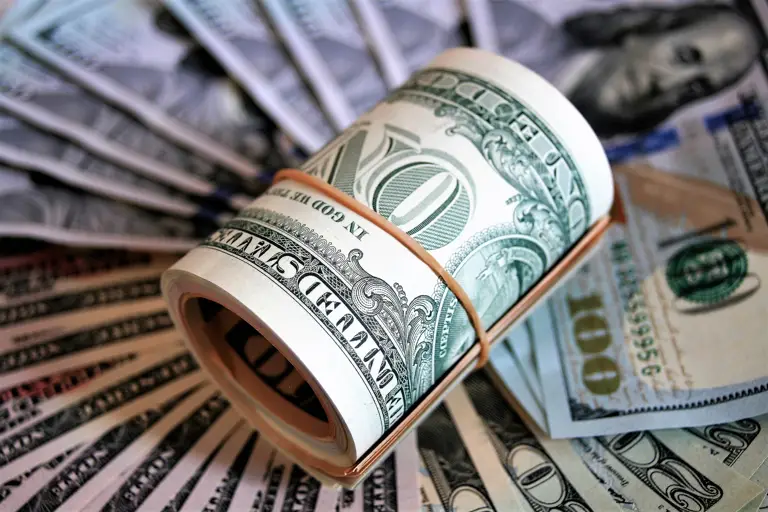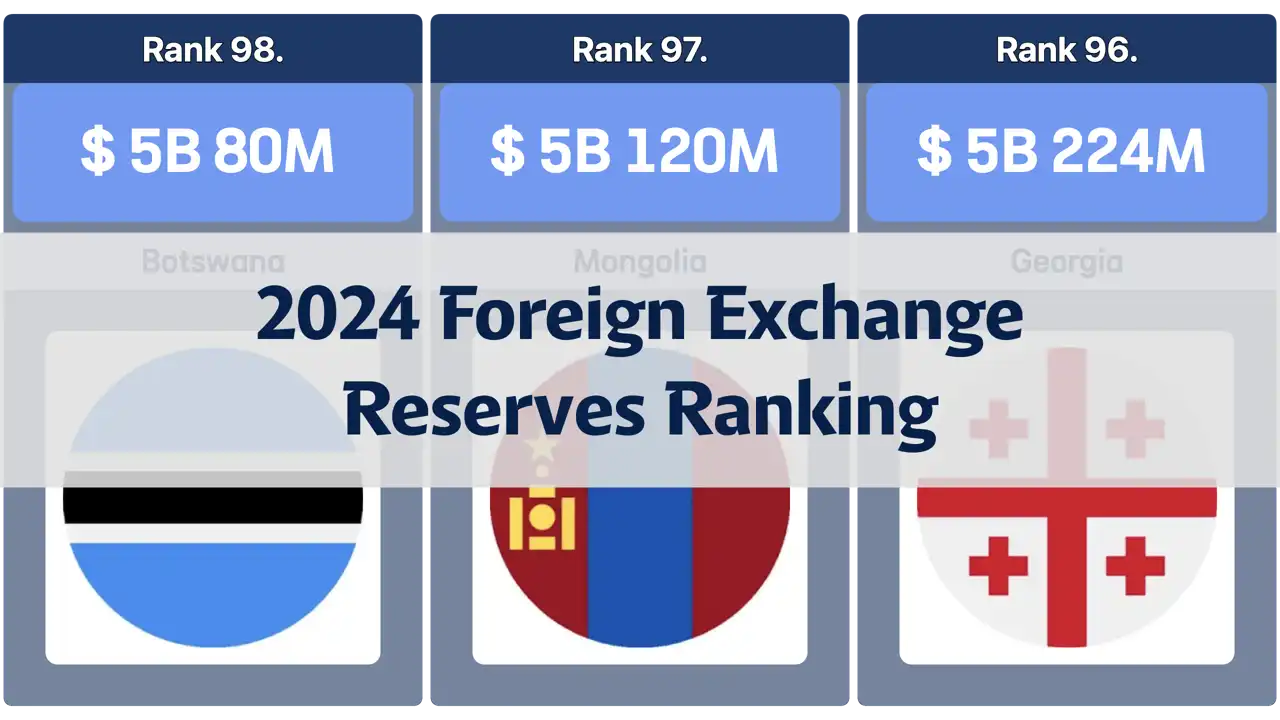
Which countries are holding the world's largest forex reserves in 2024? Let's take a deep dive into the top 10!
- ASUMUP
- Economy
- August 31, 2024
Foreign exchange reserves are a crucial metric for gauging a nation's economic health and stability. These reserves, often held in various currencies such as the U.S. dollar, euro, or yen, are used by countries to manage their currencies' values, facilitate international trade, and ensure economic stability during financial crises. In 2024, the distribution of forex reserves continues to reflect global economic dynamics, with the top holders being some of the largest and most influential economies. Interestingly, while a nation's size and economic power often correlate with larger reserves, there are exceptions that reveal the strategic priorities and financial strategies of different countries.
In this post, we’ll explore the top 10 countries with the largest forex reserves in 2024. From Asia to Europe, these nations play a pivotal role in the global economy, and their reserves are a testament to their financial strategies and economic priorities. We'll also take a closer look at the United States, which, despite being the largest economy globally, doesn't make the top 10 list, standing at 15th. Let's dive in to understand which countries are leading in this critical financial metric and why.
Top 10 Countries with the Largest Forex Reserves in 2024
- 1st China - $3.6 trillion
- 2nd Japan - $1.8 trillion
- 3rd Switzerland - $795.4 billion
- 4th India - $674.9 billion
- 5th Russian Federation - $606.1 billion
- 6th Taiwan - $568.1 billion
- 7th Saudi Arabia - $455.2 billion
- 8th Hong Kong SAR - $425.2 billion
- 9th Republic of Korea - $419.4 billion
- 10th Mexico - $364.2 billion
- 15th United States of America - $242.7 billion
15th United States of America - $242.7 billion
The United States of America, despite being the world’s largest economy, ranks 15th in terms of foreign exchange reserves, with a total of $242.7 billion. The relatively low ranking of the U.S. in this category is partly due to its unique position as the issuer of the world's primary reserve currency, the U.S. dollar. As a result, the U.S. has less need to hold large amounts of foreign currency. This also reflects the strength of its economic and financial systems, which rely more on the inflow of capital and the value of the dollar rather than on holding large reserves.
10th Mexico - $364.2 billion
Mexico holds the tenth-largest foreign exchange reserves globally, with a total of $364.2 billion in 2024. These reserves are an essential part of Mexico's economic strategy, providing a financial buffer that helps to stabilize the Mexican peso and manage the country's external debt. Mexico's reserves have grown over the years, supported by remittances, oil exports, and foreign investments. The Bank of Mexico manages these reserves to ensure that the peso remains stable, particularly during periods of global economic volatility.
In addition to stabilizing the currency, Mexico's forex reserves also play a crucial role in maintaining investor confidence and supporting the country's creditworthiness. This financial stability is vital for Mexico, especially as it continues to navigate challenges such as economic reforms and fluctuating oil prices. As one of the largest economies in Latin America, Mexico's reserves are a key factor in its economic resilience.
9th Republic of Korea - $419.4 billion
The Republic of Korea ranks ninth globally, with foreign exchange reserves totaling $419.4 billion in 2024. These reserves are a key part of South Korea's economic strategy, providing a buffer against external economic shocks and helping to stabilize the Korean won. South Korea's reserves have been built up over years of trade surpluses, particularly from its strong export sectors, including electronics, automobiles, and shipbuilding.
The Bank of Korea manages these reserves to ensure that the won remains competitive in global markets, which is crucial for South Korea’s export-driven economy. Additionally, the reserves play a vital role in maintaining investor confidence and supporting the country's financial system during periods of global economic uncertainty. As South Korea continues to be a major player in the global economy, these reserves will be essential for sustaining its economic growth and stability.
8th Hong Kong SAR - $425.2 billion
Hong Kong SAR holds the eighth-largest foreign exchange reserves in the world, with a total of $425.2 billion in 2024. These reserves are crucial for maintaining the stability of the Hong Kong dollar, which is pegged to the U.S. dollar under a currency board system. The Hong Kong Monetary Authority (HKMA) manages these reserves to ensure that the currency peg is maintained, which is vital for Hong Kong's role as a global financial hub.
The large forex reserves also provide a buffer against potential financial crises, allowing Hong Kong to defend its currency and maintain investor confidence during periods of market volatility. Additionally, these reserves support Hong Kong's financial stability, which is critical given its open economy and reliance on international trade and investment. As one of the world's leading financial centers, maintaining these reserves is essential for Hong Kong's continued economic success.
7th Saudi Arabia - $455.2 billion
Saudi Arabia holds the seventh-largest foreign exchange reserves globally, with a total of $455.2 billion in 2024. These reserves are central to Saudi Arabia's economic strategy, particularly given its reliance on oil exports. The reserves provide a cushion that allows Saudi Arabia to stabilize its economy during periods of fluctuating oil prices. Managed by the Saudi Arabian Monetary Authority (SAMA), these reserves are also used to support the Saudi riyal and to ensure that the country can meet its international financial obligations.
Saudi Arabia's forex reserves are also a key part of its Vision 2030 plan, which aims to diversify the economy away from oil dependence. By maintaining large reserves, Saudi Arabia can invest in various sectors and support economic reforms that are crucial for its long-term economic stability. The reserves also enhance the country's ability to attract foreign investment, which is essential for achieving its ambitious economic goals.
6th Taiwan - $568.1 billion
Taiwan ranks sixth in the world with foreign exchange reserves totaling $568.1 billion in 2024. These reserves are a vital part of Taiwan's economic strategy, helping to stabilize the New Taiwan dollar (NTD) and maintain financial stability in a region often marked by geopolitical tensions. Taiwan's reserves have been bolstered by its strong export sector, particularly in electronics and semiconductors, which are critical components of the global supply chain.
The Central Bank of the Republic of China (Taiwan) uses these reserves to manage the NTD's value, ensuring that Taiwan's exports remain competitive in global markets. Additionally, the reserves provide a safety net for Taiwan's economy, allowing it to absorb external shocks and maintain investor confidence. As Taiwan continues to play a crucial role in global technology supply chains, its large forex reserves will remain an essential part of its economic strategy.
5th Russian Federation - $606.1 billion
The Russian Federation ranks fifth globally, with foreign exchange reserves totaling $606.1 billion in 2024. These reserves are a critical part of Russia's economic strategy, particularly in the face of international sanctions and economic challenges. The reserves provide a buffer that allows Russia to stabilize the ruble and manage its external debt. Over the years, Russia has strategically accumulated these reserves, particularly during periods of high oil and gas prices, which have been a major source of revenue for the country.
In addition to providing economic stability, Russia's forex reserves are also used to support its sovereign wealth funds, which are invested in various assets globally. This strategy not only diversifies Russia’s economic portfolio but also ensures that the country has sufficient resources to weather global economic fluctuations. Despite facing significant economic pressures, Russia’s large reserves demonstrate its resilience and ability to manage its economy under challenging conditions.
4th India - $674.9 billion
India holds the fourth-largest foreign exchange reserves in the world, with $674.9 billion in 2024. These reserves are a key part of India's economic strategy, providing a buffer against global economic shocks and helping to stabilize the Indian rupee. India's forex reserves have grown significantly over the years, driven by its expanding economy and increasing foreign investments. The Reserve Bank of India (RBI) actively manages these reserves to support the rupee during periods of volatility and to ensure that the country can meet its international financial obligations.
India's large forex reserves also play a crucial role in enhancing the country’s creditworthiness on the global stage, making it easier to attract foreign investment. The reserves provide a financial safety net that helps to maintain investor confidence, particularly during times of global economic uncertainty. As India continues to grow as a major economic power, maintaining these reserves will be vital for sustaining its economic momentum.
3rd Switzerland - $795.4 billion
Switzerland ranks third globally in foreign exchange reserves, holding $795.4 billion as of 2024. The Swiss National Bank (SNB) actively manages these reserves, which are crucial for maintaining the stability of the Swiss franc, one of the world's most stable and sought-after currencies. Switzerland’s large reserves are a reflection of its strong financial sector, which attracts capital from around the world due to its reputation for stability and security.
These reserves also allow the SNB to intervene in the foreign exchange markets to prevent excessive appreciation of the Swiss franc, which could harm Switzerland's export-driven economy. Switzerland's approach to managing its forex reserves is conservative, focusing on preserving the value of its assets while ensuring that the country remains a safe haven for investors during times of global economic uncertainty.
2nd Japan - $1.8 trillion
Japan holds the second-largest foreign exchange reserves in the world, totaling $1.8 trillion in 2024. These reserves are essential to Japan's economic strategy, providing a cushion against financial crises and currency fluctuations. Japan's significant reserves stem from its robust export economy, particularly in high-value sectors like automobiles and electronics. The Japanese government uses these reserves to stabilize the yen during periods of volatility, ensuring that its exports remain competitive in the global market.
Moreover, Japan's forex reserves are a critical tool for maintaining investor confidence in the Japanese economy. By holding large reserves, Japan can intervene in the foreign exchange market to prevent excessive yen appreciation, which could hurt its export-driven economy. This strategy has been a cornerstone of Japan's economic policy, allowing it to navigate the challenges of a globalized economy while sustaining growth and stability.
1st China - $3.6 trillion
China continues to hold the world's largest foreign exchange reserves, amounting to a staggering $3.6 trillion in 2024. These reserves are a cornerstone of China's economic strategy, providing a buffer against external economic shocks and ensuring the stability of the Chinese yuan in global markets. China’s massive forex reserves are largely a result of its trade surplus, driven by its role as the world’s largest exporter. Additionally, China's government actively manages these reserves to influence the yuan's value and support its long-term economic goals, such as the Belt and Road Initiative. These reserves also give China significant influence in international financial markets, making it a central player in global economic affairs.
Beyond economic stability, these reserves allow China to invest in various global assets, ranging from U.S. Treasury bonds to infrastructure projects in developing countries. This strategic use of forex reserves not only generates returns but also extends China's geopolitical influence. As China continues to expand its global reach, maintaining this vast reserve is crucial for its long-term economic and political objectives.
Other Posts in the Economy
Categories
- National Rankings(43)
- Science & Technology(1)
- Sports(24)
- Economy(30)
- Society(12)
- Culture(7)
Recent Posts
![Bayern Spent HOW MUCH on Harry Kane?! Ranking Their Top 10 Biggest Signings Ever]() A deep dive into Bayern Munich's ten most expensive transfers, exploring how the club's spending strategy has evolved to chase European glory.
A deep dive into Bayern Munich's ten most expensive transfers, exploring how the club's spending strategy has evolved to chase European glory.![Arsenal's Record-Shattering Spree: From a €116M Gamble to a Flop, Who Was Worth the Cash?]() A deep dive into Arsenal's top 10 most expensive signings, analyzing the successes, the failures, and the massive fees that have defined the club's modern transfer strategy.
A deep dive into Arsenal's top 10 most expensive signings, analyzing the successes, the failures, and the massive fees that have defined the club's modern transfer strategy.![Chelsea Cashes In BIG TIME! Who Really Won the 25/26 Summer Transfer Window Money Game?]() A deep dive into the top 10 clubs that made the most money from player sales during the wild 25/26 summer transfer window.
A deep dive into the top 10 clubs that made the most money from player sales during the wild 25/26 summer transfer window.![Liverpool's Record-Breaking €483M Spree! Did They Just Buy the Premier League Title?]() A deep dive into the 25/26 summer transfer window reveals Liverpool's record-breaking spending spree as Premier League clubs continue to dominate the market.
A deep dive into the 25/26 summer transfer window reveals Liverpool's record-breaking spending spree as Premier League clubs continue to dominate the market.![You Won't Believe How Much a Loaf of Bread Costs in These Countries! (Spoiler: It's INSANE)]() This post explores the top 10 countries with the most expensive bread, revealing how factors like import reliance and tourism dramatically inflate the cost of this basic staple.
This post explores the top 10 countries with the most expensive bread, revealing how factors like import reliance and tourism dramatically inflate the cost of this basic staple.

















